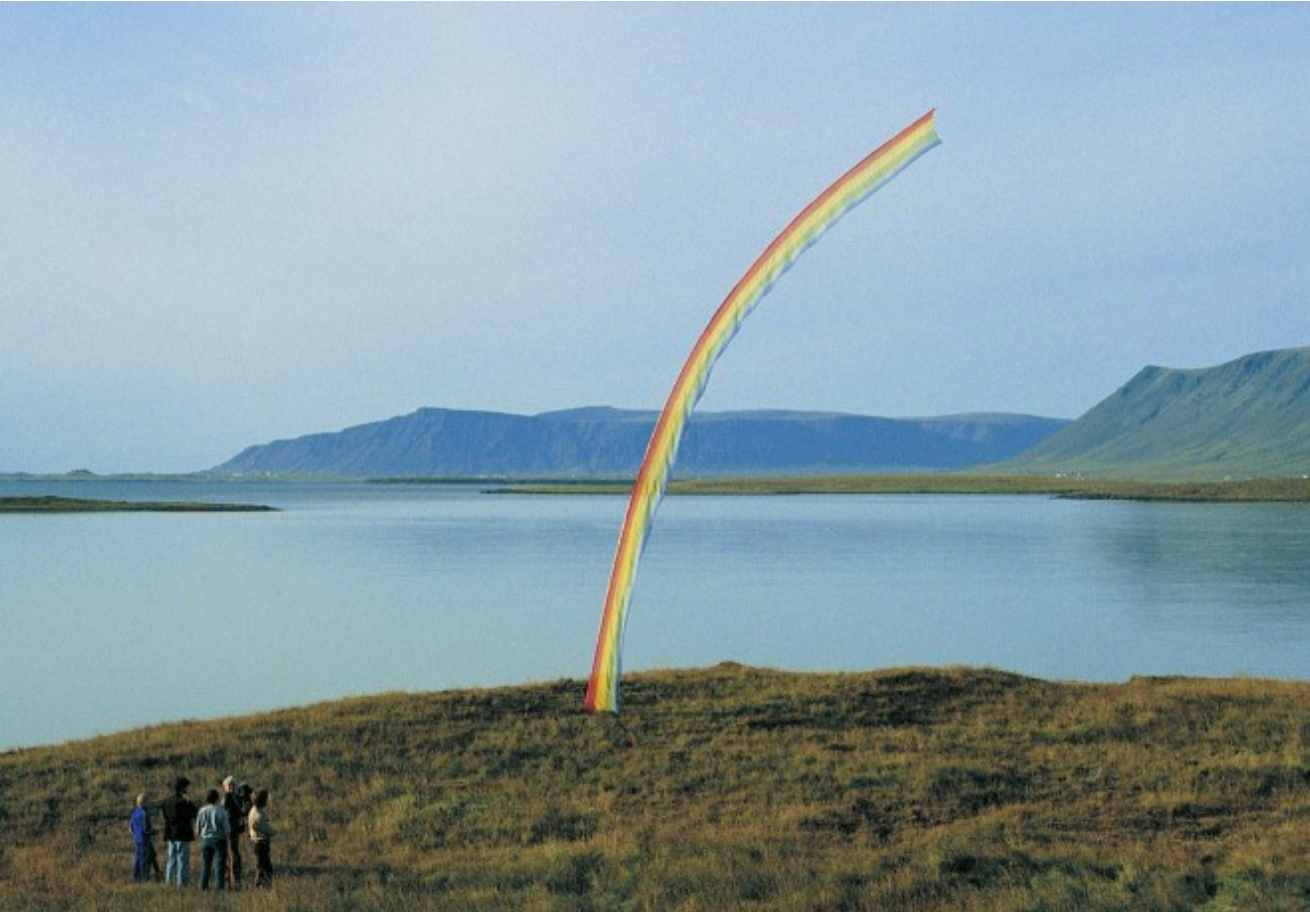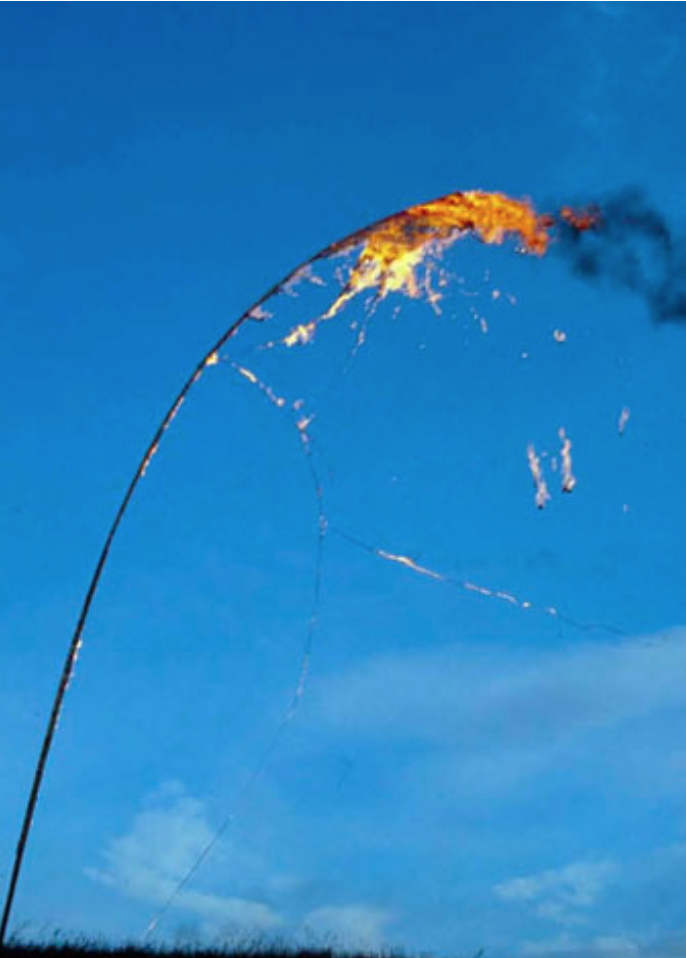Rúrí’s Rainbow I: The Burning of Being
March 7th, 2021
By Vala Schriefer

Rainbow I, Rúrí. Height, 1700 cm. Duration, 20 min. Korpúlfsstaðir, Reykjavík, August 25, 1983.
(Source: https://ruri.is/2011/09/26/rainbow/)
On August 25, 1983 at Korpúlfsstaðir, Icelandic artist Rúrí set ablaze a seventeen-meter-high arcing fabric rainbow. The performance Rainbow I lasted twenty minutes as the flames tore up and disintegrated the colorful fabric along the suspended curve, leaving only the supporting spine.

(Source: https://ruri.is/2011/09/26/rainbow/)
Erected on the very lip of the ocean before a landscape of mountains and unobstructed sky, the rainbow-sized arc both belongs and does not belong here. Its imitation of a natural phenomenon to scale makes it “fit” within the space it occupies. It follows the typical route of the natural rainbow, ground to sky, a ROYGBIV colored streak that ends with a familiar disappearance mid-journey. But it also feels totally out of place, totally bizarre. This is evidently a manmade object, something we could walk around, reach out and touch if we were there. The uncanniness of this natural-unnatural element diffuses into the organic environment around it, rendering the real space strange as well. The landscape then appears almost like a postcard with a photoshopped rainbow. Indeed, the location itself is already quite extraordinary, with a mirror-slick ocean, vast sky, and clear mountains. For the live audience spectating in 1983, the artificiality of the object, its mimicry of nature in nature, awakens a keener aesthetic receptivity to the landscape. The rainbow is not placed before a sterile wall to be experienced in isolation, but is rather en plein air where elements and forms mingle. The viewer’s receptivity to the performance bleeds into the environment itself. This is not merely because the performance takes place outside, but because the piece prompts one to consider, beyond simply the static look of a natural event, its process. Rainbow I’s theatrical meditation on the forms and properties of natural elements bridges the manmade and the natural into a unified composition.
The disappearance of the rainbow-object, that essential act of the natural rainbow, is made a kind of burlesque of a natural event. With the magic trick of its burning, the bands of color disappear; they are made transient and become a part of the flow of time. Yet the piece performs a disappearance quite unlike a real rainbow’s natural dissolution. The durable, manmade object alone, though of course not impervious to the effects of time, does not decay unlike organic material. Rúrí thus constructs the vulnerability to time by introducing the flame—the installation involves a process which undoes the object. The fire releases the rainbow from its object stasis; the constructed object must be destroyed in order to imitate the organic.

(Source: https://ruri.is/2011/09/26/rainbow/)
Rúrí’s rainbow exists in our space, like a sculpture. However, this object doesn’t just exist to be observed autonomously, from different angles as we move around it, in relation to ourselves. The rainbow-object is in direct dialogue with the environment; it wants to exist in the landscape of that day itself and be a scenic feature like the mountains and the glassy water. The rainbow-object has a funny materiality. The rainbow, an unmoving and untouchable optical illusion, is granted objecthood through fabric and a supporting beam. We see it jostled, probably wobbling from the strong sea wind, we see it physically touch the ground. The object is like a prop on a theater set; we know it is not the real thing yet can participate in the pretending. To be something akin to a real rainbow, it must be released from its materiality. The audience witnesses a manmade event of the landscape.
A rainbow is not a tangible thing but a combination of circumstances. Its appearance is due to our presence, our eye. And its disappearance is not really the disintegration of something, for it was never concrete matter to begin with, but merely the interaction of droplets, light, and the eye. When the conditions change, our eye no longer receives the light in the same way, and thus the fading of the rainbow exists equally in the eye as in the sky. Rúrí has reified this natural phenomenon—she gives pure sight a physical being-in-the-world, then takes its body away.
In the conclusion of The Renaissance: Studies of Art and Poetry, Walter Pater writes of our “continual vanishing away”—the only thing we can truly hold is grasped in the moment of perception alone. Sensory impressions belong only to a single brief instant, then vanish for good. For Pater, we are a composite of being and not being, a “strange, perpetual weaving and unweaving of ourselves.” 1 It is this sense of ourselves that we encounter when we behold a rainbow; the captivating magic of its appearance and disappearance, the wonder of this apparition, creates a sense of deep contemplative presence. Rainbow I performs the ephemeral nature of the rainbow and frames our subsequent experiences of observing rainbows. Thus, Rúrí’s installation presents not simply an abstract law of the universe, nor a science of our eyes, but a law of our very being.
Rúrí’s performance invites a self-awareness of our own finitude. In its immolation and dematerialization, the object becomes activated as a part of nature’s disappearing act, an act of which we are a part. The piece shows us the possibility of an ecstatic course towards the end. “To burn always with this hard, gem-like flame, to maintain this ecstasy, is success in life,” writes Pater of a life saturated with active awareness.2 We, like the rainbow, are a transitory moment of being. We are this act of burning though we so seldom realize it.
References
(1) Walter Pater, The Renaissance: Studies in Art and Poetry (New York: Dover Publications, 2005), 153.
(2) Pater, 154.

